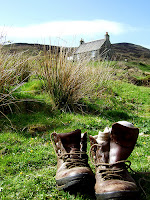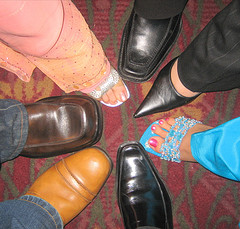This guide introduces me to the concept of Wearing Four Pairs of Shoes, developed by Ed Hootstein. I completely agree with the shoes Hootstein suggests online facilitators wear.
 |
Instructor as a Consultant, Guide, and Resource Provider
Strap on your hiking boots, because if you plan to teach/facilitate online, you need to be the guide for your learners. As a subject matter expert you are the one of the best resources for students, even if acting as a resource means pointing them in the right direction to access materials they need to thrive and survive in the class. Let learners explore the terrain, using their past experience and knowledge to draw conclusions. As long as they end up at the destination you have determined and communicated in your course objectives/expected learning outcomes, why not guide them instead of forcing them to go down your path. Providing feedback is essential when acting as a guide, especially when a learner requests it. As their guide you should let them know how they can access your help if needed and when you will be available to them.
 |
| Image Credit |
The "sole" of this shoe is all about modeling "interaction techniques," according to Hootstein. When expecting certain communication behaviors it is just as important for the facilitator to participate in ways they expect their learners to engage with the material and one another. Too many times I see online facilitators posting discussion board questions, week after week, and never going back to offer feedback, clarification, or to keep learners on topic. Learners will naturally be more motivated to participate when they see their instructor participating. Monkey see, monkey do, right?
 |
| Image Credit |
(Don't ask me why these are the shoes I have in mind when I think of a "program manager" or "director." I think these shoes could just as easily be worn as a guide.... Like in the theatre!)
If you followed instructional design standards, then you know that design is a huge part of course development. Sometimes the instructional designer is not the subject matter expert and doesn't even actually facilitate a course, but for the purpose of this post, let's assume the two are one. As the program manager you create course relevant documents, tutorials, rubrics, etc. As the program manager you should also be sure everyone stays on task. Do this by setting clear expectations and due dates and through rubrics. That way, you don't have to actually monitor each individual student and check in to make sure they are "on task." Simply provide them with guidelines that will help them stay on task, and stick to those guidelines.
 |
| Image Credit |
I like that Hootstein includes this as one of the pair of shoes online facilitators should own. While it is impossible to know everything about any one digital tool, it is essential to be quite familiar with a digital tool you expect your learners to use. At the very least, online facilitators should admit to their learners if they are not proficient in using the tool. Learners may even appreciate the opportunity to learn alongside their instructor, however I think more effective is to be familiar with the basics of the tool you expect learners to use. This way, as Hootstein suggests, "The more familiar facilitators are with the technology, the more they can focus on learners rather than technology." Just like it's a good idea to have a well-designed course and all your resources and content ready to go prior to the start, it's also beneficial to know how to troubleshoot and answer technical questions.
Basically I took the opportunity to use this week's blog as a way to interpret Hootstein's suggested footwear and internalize his concepts. I hope you enjoyed it!